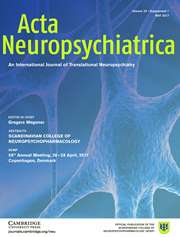No CrossRef data available.
Article contents
Systematic Review of Differentially Abundant Proteins in People with Lewy Body Dementia
Published online by Cambridge University Press: 27 March 2025
Abstract
Dementia with Lewy Bodies (DLB) and Parkinson’s Disease Dementia (PDD) are collectively called as Lewy body dementia (LBD). Despite the urgent clinical need, there is no reliable protein biomarker for LBD. Hence, we conducted the first comprehensive systematic review of all Differentially Abundant Proteins (DAP) in all tissues from people with LBD for advancing our understanding of LBD molecular pathology that is essential for facilitating discovery of novel diagnostic biomarkers and therapeutic targets for LBD.
We identified eligible studies by comprehensively searching five databases and grey literature (PROSPERO protocol:CRD42020218889). We completed quality assessment and extracted relevant data. We completed narrative synthesis and appropriate meta-analyses. We analysed functional implications of all reported DAP using DAVID tools.
We screened 11,006 articles and identified 193 eligible studies. 305 DAP were reported and 16 were replicated in DLB. 37 DAP were reported and three were replicated in PDD. Our meta-analyses confirmed six DAP (TAU, SYUA, NFL, CHI3L1, GFAP, CLAT) in DLB, and three DAP (TAU, SYUA, NFL) in PDD. There was no replicated blood-based DAP in DLB or PDD. The reported DAP may contribute to LBD pathology by impacting misfolded protein clearance, dopamine neurotransmission, apoptosis, neuroinflammation, synaptic plasticity and extracellular vesicles.
Our meta-analyses confirmed significantly lower CSF TAU levels in DLB and CSF SYUA levels in PDD, when compared to Alzheimer’s disease. Our findings indicate promising diagnostic biomarkers for LBD and may help prioritising molecular pathways for therapeutic target discovery. We highlight ten future research priorities based on our findings.
- Type
- Review Article
- Information
- Creative Commons
- This is an Open Access article, distributed under the terms of the Creative Commons Attribution licence (http://creativecommons.org/licenses/by/4.0/), which permits unrestricted re-use, distribution and reproduction, provided the original article is properly cited.
- Copyright
- © The Author(s), 2025. Published by Cambridge University Press on behalf of Scandinavian College of Neuropsychopharmacology


